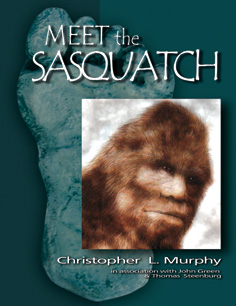”Bigger than life: New book further explores sasquatch question”
Published in the Athens Banner-Herald on Sunday, October 3, 2004
 In 2002, the Southern Anthropological Society held a four-day conference in Asheville, N.C., with a diverse agenda of academic topics ranging from the refugee crisis in the Congo to petroglyphs of Western North Carolina, and, surprisingly, bigfoot.
In 2002, the Southern Anthropological Society held a four-day conference in Asheville, N.C., with a diverse agenda of academic topics ranging from the refugee crisis in the Congo to petroglyphs of Western North Carolina, and, surprisingly, bigfoot.
That latter discussion, with five speakers, stemmed from the death of Dr. Grover Krantz, who was one of their own.
Krantz, a physical anthropologist with Washington State University, had written books on the topic of bigfoot or sasquatch, and argued there is enough evidence, both physical and eyewitness, to show an unknown species of primate lives in North America. An adult sasquatch is usually described as around 7 to 8 feet tall, walking upright and covered with hair.
Krantz died in 2002 without ever knowing the answer. And his peers at the conference discussed bigfoot as an "enduring mythic heritage'' in Southern culture. His work was criticized and his achievements noted.
There are other anthropologists in the academic field - Dr. Daris Swindler, a professor emeritus at the University of Washington, and Dr. Jeff Meldrum of Idaho State University - who also support the idea known evidence supports the existence such a rare animal exists.
Many books have been written on the subject, but now there is one that updates the evidence and provides the reader, not only with many facts, but more photographs and illustrations than can be found in any other book on the subject. This might be the most graphically interesting book ever published on the topic.
"Meet the Sasquatch'' has 480 photographs and 103 illustrations. And they are in color. The book is large. The soft-bound edition is the size of a football media guide, for those out there who know what that is.
The book was written by Christopher Murphy, who has researched the subject for 10 years, along with contributions from John Green, a journalist from British Columbia, who has been on the track of sasquatch since the 1950s, and Thomas Steenburg, an outdoorsman from British Columbia, Canada, who has researched the mystery since 1978.
The book incidentally was published to coincide with an exhibit on the sasquatch at the Vancouver Museum in Vancouver, B.C. That exhibit began in June and is slated to remain open until February 2005.
The book centers mostly on the Pacific Northwest, where the first widely publicized reports of an unknown hominid or primate surfaced. For the average person, that region is the land of bigfoot. But there are sightings in many states, including the South, but Southerners are just not prone to talk about such things. And that may be one reason so few of the sightings in South make the media.
Even skeptics, if they are willing to take a look at the evidence available, will be impressed with the book in terms of touching on the many facets of the mystery. Of course, many readers will come up with their own conclusions on the evidence, such as interpretations of a Bigfoot film or the tracks, but that's what makes the mystery of sasquatch viable. There is enough evidence to debate the subject and not relegate it to a fantasy.
While not as in-depth as some books on the subject, the book gives the reader an overview of sasquatch in the culture of Native American Indians to known reports of sightings by the first settlers as they moved into this country. It touches on what people familiar with the mystery consider the "sasquatch classics,'' such as an attack on a group of miners by sasquatch creatures near Mount St. Helens in 1924.
Much space, at least 50 pages, is spent on the famous Roger Patterson film made in 1967, which purports to show the creature. And to this day, with enhancements through computers, this remarkable film cannot be called a fake. In fact, computers have bolstered arguments that the creature is not a man in a suit, despite claims to the contrary.
The book is fascinating because it is well written and the photographs let us see a few of the people involved in the search, some of the evidence, and the places where sightings have occurred. There are maps and drawings of what Sasquatch may look like.
All in all, this is a book unlike any that has been published on the subject in terms of its graphics. Colorful and compelling, it will give the reader a good idea on why this mystery will not go away.
©
Wayne Ford for the Athen Banner-Herald, Athens, Georgia
Back to Reviews?
Back to What's New?
Back to Newspaper & Magazine Articles
Home/Main
Portions of this website are reprinted and sometimes edited to fit the standards of this website under the Fair Use Doctrine of International Copyright Law
as educational material without benefit of financial gain.
http://www4.law.cornell.edu/uscode/17/107.html
This proviso is applicable throughout the entire Bigfoot Encounters Website.